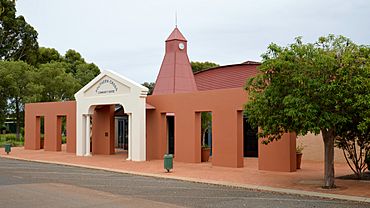Southern Cross, Western Australia facts for kids
Quick facts for kids Southern CrossWestern Australia |
|||||||||
|---|---|---|---|---|---|---|---|---|---|

Southern Cross Community Centre
|
|||||||||
| Established | 1890 | ||||||||
| Postcode(s) | 6426 | ||||||||
| Elevation | 355 m (1,165 ft) | ||||||||
| Area | [convert: needs a number] | ||||||||
| Location |
|
||||||||
| LGA(s) | Shire of Yilgarn | ||||||||
| State electorate(s) | Central Wheatbelt | ||||||||
| Federal Division(s) | O'Connor | ||||||||
|
|||||||||
Southern Cross is a town in Western Australia. It is located about 371 kilometres (230.5 miles) east of Perth, the capital city of Western Australia, along the Great Eastern Highway. The town was started in 1888 after gold was discovered there by Richard Greaves and Ted Paine in 1887. It officially became a town in 1890.
Southern Cross is the main town and administrative centre for the Shire of Yilgarn. In 2016, the town had a population of 680 people.
This town is also an important stop along the Goldfields Water Supply Scheme pipeline. This amazing pipeline carries water all the way from Mundaring to Kalgoorlie. It was designed by a clever engineer named C. Y. O'Connor. Because of this, Southern Cross is part of the Golden Pipeline Heritage Trail.
In the late 1800s, finding gold in the Yilgarn region near Southern Cross led to a huge increase in people moving to this dry desert area. More gold discoveries happened in Coolgardie in 1892 and Kalgoorlie in 1893.
The town gets its name from the Southern Cross constellation, which is a group of stars. Many of the streets in Southern Cross are also named after different constellations and stars.
The land around Southern Cross is used to grow wheat and other cereal crops. The town has a special site where Cooperative Bulk Handling (CBH) collects grain from local farms. Southern Cross is part of the O'Connor Federal electorate.
Contents
Weather in Southern Cross
Southern Cross has a dry climate. Here's a quick look at the weather:
| Climate data for Southern Cross Airfield (1996-2023) | |||||||||||||
|---|---|---|---|---|---|---|---|---|---|---|---|---|---|
| Month | Jan | Feb | Mar | Apr | May | Jun | Jul | Aug | Sep | Oct | Nov | Dec | Year |
| Record high °C (°F) | 46.3 (115.3) |
46.7 (116.1) |
42.6 (108.7) |
39.0 (102.2) |
34.0 (93.2) |
28.6 (83.5) |
26.0 (78.8) |
31.3 (88.3) |
36.8 (98.2) |
40.3 (104.5) |
44.6 (112.3) |
45.7 (114.3) |
46.7 (116.1) |
| Mean daily maximum °C (°F) | 34.8 (94.6) |
34.0 (93.2) |
30.6 (87.1) |
26.2 (79.2) |
21.4 (70.5) |
17.9 (64.2) |
16.8 (62.2) |
18.6 (65.5) |
22.0 (71.6) |
26.6 (79.9) |
30.0 (86.0) |
33.1 (91.6) |
26.0 (78.8) |
| Mean daily minimum °C (°F) | 17.9 (64.2) |
17.9 (64.2) |
15.5 (59.9) |
11.8 (53.2) |
7.3 (45.1) |
4.6 (40.3) |
3.7 (38.7) |
4.0 (39.2) |
5.7 (42.3) |
9.5 (49.1) |
13.2 (55.8) |
15.8 (60.4) |
10.6 (51.0) |
| Record low °C (°F) | 8.5 (47.3) |
7.5 (45.5) |
1.8 (35.2) |
1.4 (34.5) |
−3.4 (25.9) |
−5.0 (23.0) |
−4.8 (23.4) |
−3.8 (25.2) |
−3.2 (26.2) |
−1.7 (28.9) |
0.7 (33.3) |
5.8 (42.4) |
−5.0 (23.0) |
| Average precipitation mm (inches) | 27.5 (1.08) |
26.2 (1.03) |
34.5 (1.36) |
23.6 (0.93) |
27.1 (1.07) |
26.7 (1.05) |
34.1 (1.34) |
31.8 (1.25) |
19.7 (0.78) |
17.8 (0.70) |
17.3 (0.68) |
13.9 (0.55) |
300.2 (11.82) |
| Average rainy days (≥ 1 mm) | 2.4 | 2.5 | 3.3 | 3 | 4.1 | 5.1 | 6.5 | 5.6 | 4 | 2.9 | 2.8 | 2.1 | 44.3 |
| Average afternoon relative humidity (%) (at 3 pm) | 33.2 | 32.3 | 29.2 | 25 | 20.6 | 16.9 | 15.6 | 17.2 | 20.1 | 24.8 | 31 | 24.5 | 24.2 |
| Average dew point °C (°F) | 5.8 (42.4) |
8.0 (46.4) |
7.1 (44.8) |
7.3 (45.1) |
6.6 (43.9) |
5.1 (41.2) |
4.9 (40.8) |
4.1 (39.4) |
3.9 (39.0) |
2.4 (36.3) |
2.5 (36.5) |
5.1 (41.2) |
5.2 (41.4) |
| Source: (humidity and dew point at 3pm 1996-2010) | |||||||||||||
Railway Connections
Southern Cross has been an important stop for trains for a long time.
Old Narrow Gauge Lines
The first railway line to reach Southern Cross was a narrow gauge track on 1 July 1894. This line was part of the Eastern Goldfields Railway. The narrow gauge line that went from Southern Cross to Coolgardie (passing through Boorabbin) was closed on 29 November 1971.
Another narrow gauge line, the Wyalkatchem to Southern Cross railway line, started in 1911 and went to Bullfinch. It was fully opened in 1929. In 1933, there were plans to build a railway line 45 kilometres (28 miles) south of Southern Cross, towards Marvel Loch, but this line was never built.
In 1932, the Wheat Pool of Western Australia announced that two large grain elevators would be built at the railway siding in Southern Cross. These elevators helped store and move grain.
Some railway lines were officially closed in 1960. This included the section of the railway from Southern Cross to Mukinbudin, which was part of the line to Wyalkatchem.
Modern Standard Gauge Lines
Today, the Southern Cross railway station is on the standard gauge railway line. This line connects Perth to Kalgoorlie. The section from Perth to Southern Cross was finished on 1 May 1967. The connection all the way to Kalgoorlie, going through Koolyanobbing, was completed by 4 November 1968.
Two passenger trains use this line: the Prospector and the Indian Pacific. Both of these trains stop in Southern Cross.


